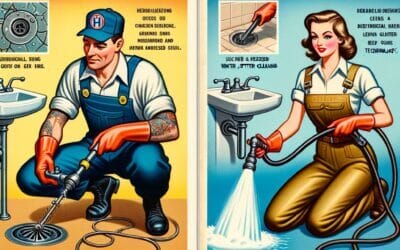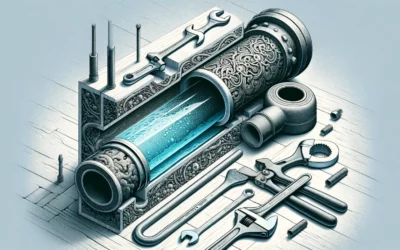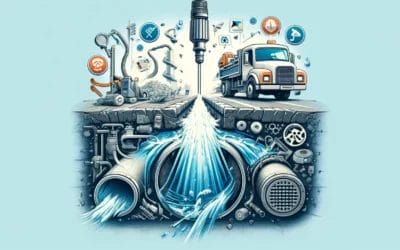Welcome everyone! Today we are diving into a topic that is quite important in our day-to-day lives – through this post titled “Understanding Low-Flow Water Fixtures: Impact on Pressure”. You may be wondering what this is about. Well, in our modern world, the demand to conserve water is increasingly important not only for environmental reasons but also for cost-saving. This is where low-flow water fixtures come in. However, concerns related to water pressure often arise when such fixtures are introduced. In this blog post, we’ll be demystifying how low-flow fixtures work, their benefits, and crucially, their impact on water pressure. So, whether you are considering a switch to low-flow fixtures or are just curious, this educational and fact-filled article can serve you as a guide. Join us as we present expert views and facts to give a better understanding of these fixtures, and hopefully answer all your questions about their influence on water pressure. Let’s explore together in an easy, helpful and informative manner.
Understanding the Basics of Low-Flow Water Fixtures
In the realm of sustainable living and water conservation, a major player has emerged: low-flow water fixtures. With the increasing concern over water scarcity, these fixtures, whether it be showerheads, toilets, or faucets, are designed to utilize significantly less water than their traditional counterparts. However, due to their distinct operation mode, many people may have concerns about the pressure and performance of these fixtures. Being aware of how low-flow water fixtures function can be a game-changer in addressing your concerns. Let’s look at some key features.
- Flow Rate: Low-flow fixtures are categorized by their rate of water flow. According to the U.S. Environmental Protection Agency (EPA), to attain the “WaterSense” label, showerheads must not exceed a flow rate of 2.0 gallons per minute (gpm) at 80 pounds per square inch (psi) of pressure, while standard fixtures use about 2.5 gpm.
- Pressure Compensation: Many. low-flow fixtures include pressure-compensation features. This technology allows the fixtures to maintain a steady flow rate regardless of the pressure in your water supply. This means even under lower pressure, the water stream from these fixtures remains consistent.
- Efficient Design: Modern designs of low-flow fixtures are quite efficient. They mix air with the water stream to induce a sense of added force. This gives the impression of high pressure and results in a satisfactory user experience.
Now, comparing a WaterSense-labeled showerhead with a standard one, we can see how much water (and subsequently, the money) we can save per year:
| Type of Showerhead | Average Water Use (per shower) | Annual Water Use (per person) | Projected Annual Savings1 |
|---|---|---|---|
| Standard | 25 gallons | 9,125 gallons | — |
| WaterSense-labeled | 20 gallons | 7,300 gallons | 1,825 gallons2 |
1 Assuming a daily 10-minute shower. 2 Savings may be more or less depending on local water rates. As seen from the above comparison, you can save a substantial amount with low-flow fixtures without compromising on water pressure or fixture performance. In essence, low-flow fixtures offer a straightforward route to water conservation and savings while staying mindful of our resources.
The Science Behind Water Pressure in Low-Flow Fixtures
The complex inner workings of low-flow fixtures are driven by the elementary laws of physics and fluid dynamics. While initially a common belief was that these low-flow models might struggle to maintain optimal water pressure, we now understand that the size of the fixture itself doesn’t necessarily directly impact the water pressure. Instead, internal hardware adjustments and different mechanical layouts ward off any such potential issues.
The critical factor at play here falls under fluid dynamics – known as Bernoulli’s principle. To paraphrase, Bernoulli’s principle denotes that an increase in the speed of a fluid occurs simultaneously with a decrease in its potential energy. So, within a low-flow fixture, the water’s speed increases due to the smaller diameter of the fixture, which reciprocally maintains, or even amplifies, the pressure.
- The Internal Valve: This component controls the flow of water, making efficient use of your water supply without affecting pressure.
- Aerator: It breaks the flow of water into small droplets, increasing the perceived pressure and reducing splash.
Experts also recommend considering the water pressure in your household while vsing low-flow fixtures. Consider conducting a water-pressure test in your home before opting for low-flow fixtures. While such fixtures are incredibly efficient and effective once functioning correctly, houses with inherently low water pressure may require additional interventions to optimize pressure.
| Factors | Impact on Water pressure |
|---|---|
| Fixture Diameter | Smaller diameter accelerates water speed thereby maintaining pressure |
| Internal Valve | Controls flow of water to enhance efficiency |
| Aerator | Increases perceived pressure by breaking water into droplets |
| Household Water Pressure | Existing low pressure may need additional interventions despite efficient fixture |
Note: Poke around the internet, and you’ll find numerous tutorials on performing a water-pressure test at home, although hiring a professional plumber might also prove beneficial for holistic assessment and possible solutions. Happy plumbing!
Real-world Impact of Low-Flow Fixtures on Water Pressure
Low-flow fixtures have been a boon for water conservation efforts across the globe. However, the real-world impact these fixtures have on water pressure in homes and businesses can cause some concern. It’s important to understand that low-flow does not mean low-pressure. A well-designed low-flow fixture should provide adequate pressure for its intended task, such as washing dishes or taking a shower. In a bid to reduce water usage, low-flow fixtures utilize a mechanism that controls the flow of water through the fixture, limiting it to a pre-set maximum. This targeted flow control can sometimes be mistaken for low water pressure, especially when transitioning from conventional fixtures that consume large amounts of water. Moreover, it’s crucial to note that these fixtures offer multiple pros:
- Significant reduction in water usage, leading to cost savings
- They help in environmental conservation efforts
- They maintain or sometimes even improve overall functionality
Next, let’s break down their influence on water pressure employing a simple table:
| Low-Flow Fixture | Water Pressure Perception |
|---|---|
| Showerheads | Since these are designed to provide a pleasant showering experience, the pressure is usually optimized, and only minimal difference is felt compared to conventional fixtures. |
| Faucets | As most users do not rely on high pressure for tasks like washing hands or dishes, the perceived difference in pressure is usually negligible. |
| Toilets | Due to their design, low-flow toilets function correctly even with significantly less water, and thus perceived pressure drop is rare. |

The Pros and Cons of Low-Flow Water Fixtures: An Expert Insight
How Does Low Flow Affect Water Pressure? Low-flow water fixtures, as their name suggests, are designed to reduce the amount of water flow in your bathroom or kitchen. This might make you worry about the impacts on water pressure. However, with modern technology, you get to save water without compromising on the shower experience. The mechanism behind low-flow fixtures involves a restriction in the diameter of the pipe or the fitting, which can indeed potentially reduce the water pressure when you open the tap. But to compensate for this, most of these fixtures come with pressure compensating aerators that keep the flow steady even at varying pressures. Pros and Cons of Low-Flow Fixtures
Let’s delve into the pros and cons of these water-saving fixtures.
- Pros
| Water Efficiency | These fixtures majorly help in water conservation, significantly reducing your water usage by up to 60%. |
| Energy Savings | Less water usage means less energy spent on heating water, saving you more on energy bills. |
- Cons
| Fixture Cost | Low-flow fixtures can be more expensive initially than their regular counterparts. |
| Reduced Pressure | Although equipped with pressure compensating aerators, these fixtures may provide slightly less pressure compared to regular fixtures especially in houses with already low water pressure. |
Nevertheless, the benefits of low-flow water fixtures clearly outweigh the cons. While the initial cost might be higher and there might be a small reduction in water pressure, the long-term energy and water savings are substantial.
Practical Tips for Managing Water Pressure with Low-Flow Fixtures
Low-flow water fixtures have become a go-to solution for homeowners hoping to cut down on water consumption, resulting in significant savings on water bills. However, these fixtures could potentially alter your water pressure. Thus, to maintain a comfortable and functional water pressure level while reaping the benefits of low-flow fixtures, here are few practical tips:
- Regular maintenance: Check your fixtures regularly for mineral buildup which can reduce the flow of water, thus decreasing water pressure.
- Pressure Reducing Valve (PRV) settings: Adjust your home’s PRV to increase the water pressure. Remember, it’s essential to have a perfect balance as high pressure could damage the fixtures.
- Opt for quality low-flow fixtures: Not all low-flow fixtures are constructed equally. High-quality fixtures will have a design that provides a feeling of adequate pressure, even with less water flow.
- Usage scheduling: Avoid simultaneous use of multiple water fixtures, as this can reduce water pressure noticeably.
In the context of managing water pressure with low-flow fixtures, it’s important to understand the basic mechanism behind these water-saving wonders. Low-flow fixtures utilize ‘flow restrictors’ to decrease water usage. The table below presents how different types of low-flow fixtures work and their impact on water pressure.
| Fixture Type | Mechanism | Impact on Water Pressure |
|---|---|---|
| Low-flow showerhead | Uses aerators or laminar flow technology to mix water with air, allowing less water to be consumed while maintaining a strong flow. | Air-powered technology provides the sensation of stronger water pressure, even with reduced water flow rate. |
| Low-flow faucet aerators | It filters the flow into small, uniform streams that consume less water. | Even with a reduced flow rate, a uniform, steady stream usually makes water pressure issues unnoticeable. |
| Dual Flush toilets | Gives user the option to select from two different water volume levels to flush waste. | Lower flush setting uses less water, but typically does not affect perceived water pressure. |

Improving Water Efficiency: Suggested Low-Flow Water Fixtures for Different Needs
Reducing our water footprint starts with implementing household solutions that boost water efficiency. Central to this is the use of low-flow water fixtures, which are designed to restrict the flow rate of water from faucets, showers, and toilets. In essence, these fixtures conserve water and energy—though some people worry about their potential effect on water pressure.
To clear up any misconceptions, let’s tackle the real impact of low-flow water fixtures on water pressure. Truthfully, low-flow fixtures don’t reduce water pressure; rather, they control the flow rate—or how quickly water is dispensed. Your pressure stays the same, it’s just that less water is released over time. With options like low-flow showerheads, aerated faucets, and high-efficiency toilets, meeting different needs while conserving water has never been easier.
Here’s a quick glance at the potential water savings these fixtures could offer:
| Low-Flow Fixture | Potential Water Savings |
|---|---|
| Low-Flow Showerhead | Up to 2.5 gallons per minute |
| Aerated Faucet | Half a gallon to a full gallon per minute |
| High-Efficiency Toilet | 1.6 gallons per flush |
By introducing these low-flow fixtures into our homes, we’ll use less water, reduce our utility bills, and, most importantly, contribute positively towards the eficiency of global water consumption.
In closing, understanding the impact of low-flow water fixtures on pressure is paramount in making informed decisions about your household utilities. These environmentally-friendly fixtures can drastically reduce water consumption, leading to significant cost savings on your water bills. Yet, the myth that they compromise the overall water pressure is largely unfounded. With modern advancements and technologies, low-flow fixtures have been designed to not only conserve water, but also maintain adequate water pressure for everyday household needs. As we strive to make our homes more efficient and eco-friendly, low-flow fixtures stand as a viable solution that aligns with these goals. We hope this article has been both informative and helpful, equipping you with the essential knowledge you need to optimize your water usage. Remember, every drop we save contributes to a sustainable water future.







